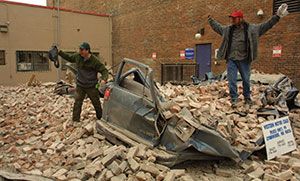New design standards created by a group of engineers would require that hospitals, police stations and schools be strong and tall enough to survive a tsunami and provide shelter.
The current strategy for surviving a Cascadia Subduction Zone tsunami can be summed up in three words: Run like hell.
Scientists and emergency managers have estimated wave heights and arrival times and mapped out the shortest routes to high ground, but residents will be on their own in the chaotic aftermath of an offshore megaquake.
In some places, like Washington’s Long Beach Peninsula or Ocean Shores, even the fleetest runners could never make it to safety in time and few — if any — buildings are likely to survive the wall of water that will hit after the shaking stops.
That grim outlook inspired a group of leading engineers to create the nation’s first design standards for tsunami-safe structures. If incorporated into building codes as the engineers hope, the standards would require that new, critical facilities like hospitals, police stations and schools in vulnerable areas be strong enough to withstand the tsunami and tall enough that occupants won’t be swept away.
SEISMIC NEGLECT

More from the series:
- 'This is an urgent issue': Seattle makes little progress on buildings that can kill in earthquakes
- Overview: Washington's earthquake risks
- A quake worse than the ‘Big One’? Ruined New Zealand city shows danger in Seattle
- 4 key ways Seattle can prepare
- Quake-insurance prices soar in Washington, and companies hold all the power
- Quake insurance in Washington: What you need to know
- Washington state’s plan for megaquake ‘grossly inadequate,’ review finds
- Buildings that kill: The earthquake danger lawmakers have ignored for decades
- Is your child safe? Washington does little to protect older schools from earthquakes
- Tips for parents to find out more
- Guide to earthquake preparedness
“We’re basically trying to save lives,” said Gary Chock, chair of the American Society of Civil Engineers’ (ASCE) subcommittee that drew up the standards. “The idea that you would essentially write off whole communities is not acceptable.”
The standards, which would also apply in coastal areas of California, Hawaii and Alaska, will be unveiled Wednesday in Portland at the ASCE’s annual convention.
But their fate is already uncertain, due to a broader challenge from building industry groups, including the National Association of Homebuilders.
Writing the tsunami standards was a five-year process, Chock said. “Before this, tsunamis were essentially ignored in design.”
Most Read Local Stories
While some Northwest communities hope to move schools and other critical facilities to high ground, that’s not always practical or affordable, Chock pointed out. But if new facilities in the tsunami zone are built to the standards, not only would they remain usable after the disaster, but they could also provide safe havens to escape the water, he said.
Real-life and lab studies
Chock and other engineers visited Japan and Chile to detail building damage from recent, massive tsunamis. They conducted laboratory experiments, including at Oregon State University’s O.H. Hinsdale Wave Research Laboratory, to estimate the force exerted by fast-moving water laden with debris. Scientists at the National Oceanic and Atmospheric Administration’s Center for Tsunami Research and the University of Washington used computer models to simulate thousands of possible tsunami scenarios.
Chock said some of the most valuable insights came from Japan’s Tohoku coast, where the 2011 tsunami killed more than 15,000 people. In some places, the water was so powerful it blasted through reinforced concrete walls, shoved multistory buildings onto their sides or scoured away foundations.
But many buildings constructed of steel or concrete remained standing.
“Tens of thousands of people survived by going into these buildings,” Chock said.
Only one building in the United States was designed to serve as a tsunami refuge. Ocosta Elementary School on the Washington coast near Westport dedicated its new gymnasium this summer, with external stairways for quick access and room on the roof for 2,000 people. Architects and engineers worked closely with Chock and his team to be sure the gym met the new standards.
Officials at Oregon State University say a $50 million marine science building planned for the waterfront in Newport will also be designed according to the new standards.
To establish how tall buildings need to be to avoid being overtopped, NOAA and UW tsunami modeler Yong Wei and his colleagues relied on computer simulations to estimate the largest tsunami likely to strike in a 2,500-year period. On the Washington and Oregon coast, that translates into surges that could range from 16 to 100 feet high, depending on the local terrain.
The standards also cover areas like the Seattle waterfront, which could be flooded with 20 feet of water if the Seattle Fault, which passes under Puget Sound, ruptures.
Researchers at Lehigh University in Pennsylvania suspended a 3.5-ton shipping container by cables and slammed it into a wall to estimate the force exerted on buildings by the huge amounts of debris swept up in tsunamis. At OSU’s wave tank, scientists created artificial tsunamis and cityscapes to validate estimates of water speed and depth, and worked with scale models of shipping containers to study the way debris slams into buildings.
“It was really cool to be part of something that’s going to make a difference for our communities,” said OSU engineering professor Dan Cox.
Resistance over costs
The standards are included in the new, 2018 version of the International Building Code. But it’s up to individual states and counties to decide which provisions of the international code to adopt, Chock explained.
If the process goes smoothly, he estimates the tsunami standards could take effect by 2020.
But ASCE’s entire package of new standards, which includes measures to strengthen roofs in hurricane-prone parts of the country and bolster the seismic safety of buildings in the Midwest, faces objections from building groups that argue some of the provisions are too costly.
If that challenge is upheld, then the tsunami standards would remain on hold, ASCE’s Ronald Hamburger wrote in an email.
Even if adopted, the standards would apply only to the small subset of buildings considered critical or essential, like power plants and fire stations, or structures like auditoriums or convention centers where large numbers of people gather. It would not apply to single-family homes, condos, apartments or most hotels.
But communities would have the option of applying the standards to other types of buildings, like parking structures that could double as tsunami refuges, Chock pointed out.
Tsunami-safe buildings do cost more, but Chock estimates the premium would amount to only about 1 percent to 3 percent of the total building price tag in most places.
“From a local jurisdiction standpoint, these standards provide some powerful tools to think about the outcome you want to have after one of these tsunamis,” Chock said. “Do you want to have people survive? Do you want to have a core of buildings, like your hospital, survive — or are you basically saying: We give up?”
